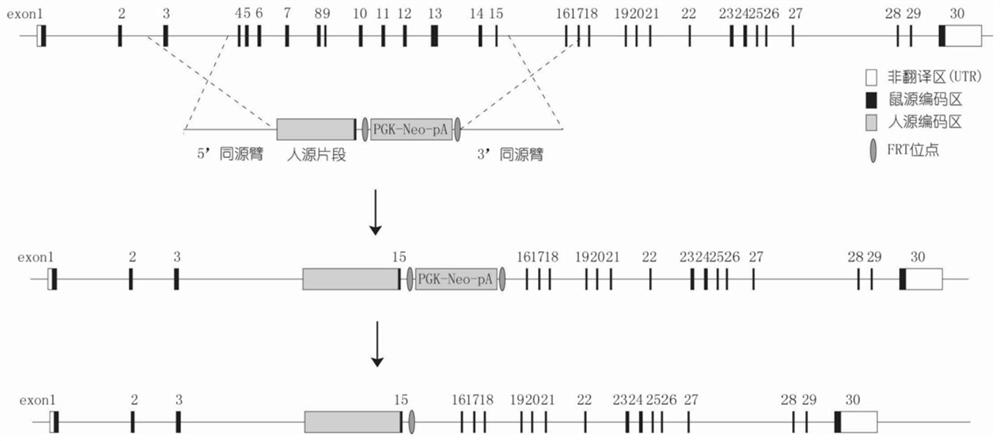Construction method and application of humanized kdr gene modified animal model
A technology of genetic modification and construction method, applied in the field of genetic engineering, which can solve the problems of inability to use mice, drugs that do not recognize animal targets, and inability to recognize them.
- Summary
- Abstract
- Description
- Claims
- Application Information
AI Technical Summary
Problems solved by technology
Method used
Image
Examples
Embodiment 1
[0071] Embodiment 1 sequence design
[0072] Both the mouse Kdr gene and the human KDR gene contain multiple transcripts, and the sequence design in this example is mainly described using one of the transcripts as an example. That is, the 4th to 14th exon and part of the 15th exon of mouse Kdr gene (NCBI Gene ID: 16542) (based on the transcript of NCBI accession number NM_010612.3→NP_034742.2, its mRNA The sequence is shown in SEQ ID NO: 1, and the corresponding protein sequence is shown in SEQ ID NO: 2) using the 4th exon to the 14th exon and the 15th exon of the human KDR gene (GeneID: 3791) Part of the replacement (based on the transcript of NCBI accession number NM_002253.3→NP_002244.1, its mRNA sequence is shown in SEQ ID NO: 3, and the corresponding protein sequence is shown in SEQ ID NO: 4), wherein, mouse Kdr The schematic diagram of the comparison between the gene and the human KDR gene is shown in figure 1 , the schematic diagram of the transformed humanized mouse ...
Embodiment 2
[0078] Example 2 Design and Construction of Recombinant Vector PBR322-KDR
[0079] According to the sequence design, the inventor has further designed such as image 3 The targeting scheme shown and the vector containing 5' homology arm, human KDR gene fragment, mouse Kdr gene fragment, resistance gene expression cassette, and 3' homology arm. Wherein the 5' homology arm (SEQ IDNO: 9) is the 75972817-75968732 nucleotide of NCBI accession number NC_000071.6, and the 3' homology arm (SEQ IDNO: 10) is the NCBI accession number NC_000071.6 Nucleotides 75955853-75951921, human KDR gene fragment (SEQ ID NO: 11) is nucleotides 705-2501 of NCBI accession number NM_002253.3, mouse Kdr gene fragment (SEQ ID NO: 12) It is nucleotides 76116880-76116514 of NCBI accession number NC_000071.7.
[0080] The construction process of the vector is as follows: design the upstream primers for amplifying the three homologous recombination fragments (LA, KI, RA), the matching downstream primers and...
Embodiment 3
[0091] Example 3 Verification of carrier PBR322-KDR
[0092] Randomly select 5 PBR322-KDR clones, and use the restriction endonuclease EcoRV to carry out digestion verification. The digested products should have fragments of 6404bp, 5108bp, 3181bp, 2704bp, 314bp, and 104bp in size. For enzyme digestion results, see Figure 4 , the results of plasmid digestion were in line with expectations, indicating that the verification results of plasmid digestion were correct. The plasmid was verified to be correct by the sequencing company, and subsequent experiments were carried out.
PUM
 Login to View More
Login to View More Abstract
Description
Claims
Application Information
 Login to View More
Login to View More - R&D
- Intellectual Property
- Life Sciences
- Materials
- Tech Scout
- Unparalleled Data Quality
- Higher Quality Content
- 60% Fewer Hallucinations
Browse by: Latest US Patents, China's latest patents, Technical Efficacy Thesaurus, Application Domain, Technology Topic, Popular Technical Reports.
© 2025 PatSnap. All rights reserved.Legal|Privacy policy|Modern Slavery Act Transparency Statement|Sitemap|About US| Contact US: help@patsnap.com



